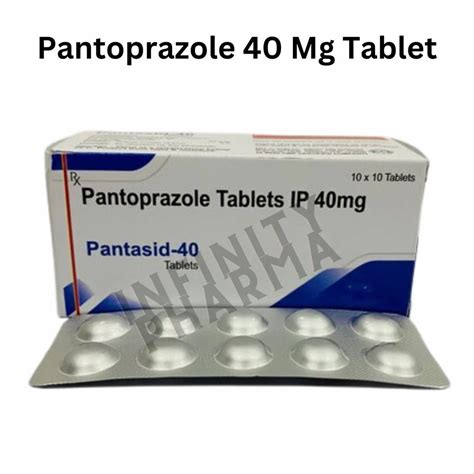Intro
Pantoprazole 40 Mg treats gastroesophageal reflux disease, erosive esophagitis, and Zollinger-Ellison syndrome, reducing stomach acid with proton pump inhibitor therapy.
Pantoprazole 40 mg is a commonly prescribed medication that belongs to a class of drugs known as proton pump inhibitors (PPIs). These medications work by reducing the amount of acid produced in the stomach, which can help alleviate symptoms and treat various conditions related to excessive stomach acid. The importance of managing stomach acid cannot be overstated, as excessive acid production can lead to discomfort, pain, and potentially serious complications if left untreated. Understanding the role of pantoprazole 40 mg in this context is crucial for individuals who are prescribed this medication or are considering its use.
The topic of pantoprazole 40 mg is particularly relevant due to its widespread use in treating a range of gastrointestinal disorders. From gastroesophageal reflux disease (GERD) to peptic ulcers, the applications of pantoprazole are diverse and significant. As such, delving into the specifics of how pantoprazole works, its benefits, potential side effects, and practical considerations for its use can provide valuable insights for both healthcare professionals and patients. By exploring these aspects in depth, individuals can better understand the role of pantoprazole 40 mg in managing gastrointestinal health and make informed decisions about their treatment options.
Pantoprazole 40 mg is often prescribed for its efficacy in treating conditions characterized by excessive stomach acid. Its mechanism of action involves inhibiting the H+/K+ ATPase enzyme system at the secretory surface of gastric parietal cells, thereby reducing gastric acid secretion. This action is crucial for alleviating symptoms such as heartburn, regurgitation, and stomach pain associated with acid-related disorders. Furthermore, the use of pantoprazole 40 mg can also facilitate the healing of peptic ulcers and prevent their recurrence, highlighting its therapeutic versatility. As the pharmaceutical industry continues to evolve, medications like pantoprazole 40 mg remain essential for managing gastrointestinal health, underscoring the need for comprehensive information on their use and benefits.
Pantoprazole 40 Mg: Mechanism of Action and Benefits

Pantoprazole 40 mg works by irreversibly inhibiting the H+/K+ ATPase (proton pump) in the gastric parietal cells. This inhibition blocks the final step of acid production, reducing gastric acidity. The benefits of pantoprazole 40 mg include:
- Rapid onset of action, providing quick relief from symptoms
- Effective in healing and preventing recurrence of peptic ulcers
- Can be used in combination with antibiotics to treat Helicobacter pylori infections
- Reduces the risk of gastrointestinal bleeding in patients with a history of ulcers
Indications for Use
Pantoprazole 40 mg is indicated for the treatment of: - Gastroesophageal reflux disease (GERD) - Peptic ulcers - Zollinger-Ellison syndrome - Helicobacter pylori infections (in combination with antibiotics) - Prevention of NSAID-induced ulcersPotential Side Effects and Interactions

While pantoprazole 40 mg is generally well-tolerated, potential side effects include:
- Headache
- Diarrhea
- Abdominal pain
- Nausea
- Dizziness It is also important to be aware of potential interactions with other medications, such as:
- Warfarin, which may increase the risk of bleeding
- Ketoconazole, which may decrease the absorption of pantoprazole
- Atazanavir, which may decrease the absorption of atazanavir
Precautions and Contraindications
Pantoprazole 40 mg should be used with caution in patients with: - Severe liver disease - Osteoporosis (long-term use may increase the risk of fractures) - Magnesium deficiency It is contraindicated in patients with known hypersensitivity to pantoprazole or any component of the formulation.Dosage and Administration

The recommended dosage of pantoprazole 40 mg varies depending on the condition being treated:
- For GERD, the typical dose is 40 mg once daily for up to 8 weeks
- For peptic ulcers, the dose is 40 mg once daily for 4-8 weeks
- For Helicobacter pylori infections, a combination of pantoprazole 40 mg, amoxicillin, and clarithromycin is typically used for 7-14 days
Practical Considerations for Patients
Patients taking pantoprazole 40 mg should: - Take the medication at the same time each day - Swallow the tablets whole with water - Avoid crushing or chewing the tablets - Inform their healthcare provider about any other medications they are takingLong-Term Use and Safety

Long-term use of pantoprazole 40 mg may be associated with an increased risk of:
- Osteoporosis-related fractures
- Magnesium deficiency
- Vitamin B12 deficiency Regular monitoring and follow-up with a healthcare provider are essential for patients on long-term therapy.
Alternatives and Future Directions
For patients who cannot tolerate pantoprazole 40 mg or require alternative treatments, other options include: - Other PPIs, such as omeprazole or lansoprazole - Histamine-2 (H2) blockers, such as ranitidine or famotidine - Surgical interventions for severe or refractory casesConclusion and Final Thoughts

In conclusion, pantoprazole 40 mg is a valuable medication for the treatment of various acid-related disorders. Its efficacy, safety profile, and versatility make it a preferred choice for many healthcare providers. However, it is essential for patients to be aware of the potential side effects, interactions, and precautions associated with its use. By understanding the benefits and limitations of pantoprazole 40 mg, individuals can make informed decisions about their treatment and work closely with their healthcare providers to achieve the best possible outcomes.
We invite readers to share their experiences or ask questions about pantoprazole 40 mg in the comments section below. Your feedback and insights are invaluable in helping us create a comprehensive and supportive community for individuals seeking information on gastrointestinal health and treatment options.
What is pantoprazole 40 mg used for?
+Pantoprazole 40 mg is used to treat conditions such as gastroesophageal reflux disease (GERD), peptic ulcers, and Helicobacter pylori infections.
How does pantoprazole 40 mg work?
+Pantoprazole 40 mg works by irreversibly inhibiting the H+/K+ ATPase (proton pump) in the gastric parietal cells, reducing gastric acidity.
What are the potential side effects of pantoprazole 40 mg?
+Potential side effects include headache, diarrhea, abdominal pain, nausea, and dizziness.
